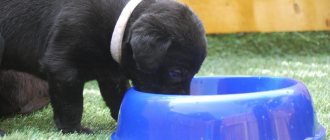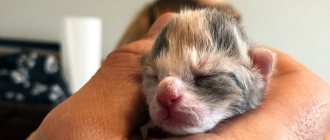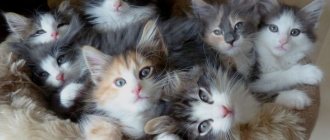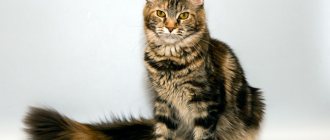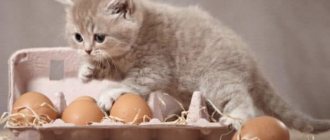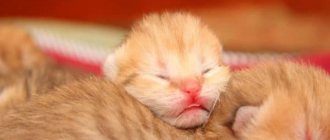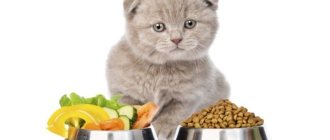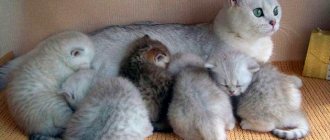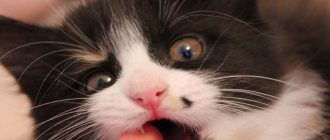In the article, we looked at the questions that owners have when introducing complementary foods to kittens. What is the best time to start complementary feeding, how and what to feed newborn kittens and kittens from one to three months. From the material you will learn which foods are prohibited for kittens to eat and why water is important for the health of the animal.
For the first three to four weeks of life, kittens feed on the milk of their mother cat. But over time, it becomes insufficient to develop properly, grow healthy and strong. At about the age of one month, kittens need to be introduced to complementary foods, which means they should begin to accustom them to adult food.
In order for kittens to grow up healthy and strong, you need to introduce complementary foods
Complementary feeding - when to start?
A small pet requires constant attention. If the owner decides to supplement the kitten’s diet, it is necessary to: analyze the health, well-being, and determine the age of the pet. A kitten needs complementary feeding at a certain age; if the animal was bought secondhand or picked up on the street, there is no need to rush to introduce meat into the diet.
The only food a mother feeds her babies for the first month and a half is breast milk. In nature, feeding with mother's milk lasts about two months, but one and a half month old kittens are already starting to try other foods.
The main rule, if you decide to adopt a kitten, is to adopt it at least 8 weeks old.
In this case, the baby will not have to be fed with formula or milk. If you decide to adopt an animal from a friend, you should wait until it grows up.
When a kitten is picked up on the street, it is difficult to independently determine its age. A veterinarian will come to the rescue. It is necessary to take the new family member to the veterinarian to find out the age, check the health, and assess the general condition. Animals taken from the street are often infected with parasites and can suffer from diseases that are dangerous to the human body.
Having determined the age, the veterinarian will advise what food it is time to give the kitten.
If:
- less than a month old - should be fed with formula milk;
- from a month to two - introduce supplementary feeding in the form of solid food;
- more than two months - feed as an adult.
If crumbs are born to a cat already living in the house, you should start feeding them no earlier than after 4 weeks.
General recommendations
If it is decided that the kittens will eat only natural food, it is advisable to accustom the pets to eating a variety of foods from the first month. You should not give your animal one product he loves and make it the main one in his diet. This can lead to digestive problems.
A great danger to a kitten's health is feeding human food in combination with ready-made food. It is also not recommended to mix expensive dry food with cheap wet food. It is better to leave only dry food, since low-quality wet food will do nothing but harm to the kitten.
Pay attention to the kitten’s fur as often as possible: if it is shiny and smooth, then the pet is healthy. If bald spots appear or the skin under the fur is irritated, you need to consult a veterinarian and purchase a special vitamin complex. But remember that in a good ready-made food, all nutrients and microelements are already balanced.
How to artificially feed?
In some cases, a situation arises when a cat refuses to feed newborn kittens, then the owner will have to feed them himself.
The best option is feeding with adapted milk formulas, which are sold in pet stores. Cow's milk and cream with various additives are also suitable.
Popular recipe: mix a glass of cow's or goat's milk at room temperature with vegetable oil (1 teaspoon), raw yolk. Beat, add honey (1 teaspoon).
Algorithm of actions:
- Prepare supplementary food. The daily norm for a newborn kitten is 22-24 ml.
- Divide feeding into 6-7 meals.
- Single dose - 3-5 ml.
- The interval between feedings is at least 2 hours.
At two weeks of age, the time between feedings should be increased by an hour; when the kitten is one month old, the number of feedings should be increased to 4 times.
Advice: for each meal you need to prepare a new portion of food; you can feed it with a pipette or pacifier. The position for breastfeeding is on the tummy.
Help the cat
The pet pleased the owners. Squeaking lumps were born. If the cat has given birth for the first time, the litter should not be too large. From 3 to 6 kids is ideal.
The mother is able to feed this number of kittens normally. If there are more of them, you will have to introduce complementary foods for the kittens, or, more correctly, supplementary feeding.
For these purposes, you can buy a cat's milk replacer. It is sold in good pet stores. It's not cheap, let's warn you right away.
You can make a substitute yourself. It is different from the store bought one, of course. But it has been tested by time and by more than one “cat person.”
- Take a liter of milk.
- Add two yolks to it.
- A teaspoon of sugar also goes here.
- Mix everything.
- Feed the kitten the heated mixture.
How to introduce complementary foods?
Kittens can be supplemented from one month of age.
- Milk porridge made from rice, semolina, and oatmeal is recommended as the first supplement.
- After a few days, you can offer boiled cereal in water, diluted with baby meat food or minced meat.
- During the week, you should increase the percentage of meat in your food, reducing the amount of cereal.
- At 8 weeks it is worth offering pure meat without added grains.
- After 8 weeks, vegetables, crushed to a puree, should be added to the diet.
Feeding Basics for Newborn Kittens
global $ads_google;
//data-ad-slot=”2475549904″ $ads_google = empty($ads_google) ? false : true; ?> if ($ads_google == false) {?> $ads_google = true; ?> } ?> If a cat does not feed newborn kittens , then the owner will have to become the mother.
To prevent the process from causing inconvenience, sit down comfortably and place a diaper on your knees. The cub is placed on the prepared bedding - it should lie as if it were being fed by a mother cat. If it is a newborn, then he is placed lying down and his head is raised slightly. It is important to ensure that your head is not thrown back excessively!
After placing the baby, they begin the feeding process itself.
Feeding methods
If you had to replace the furry mother, you need to know how to feed newborn kittens without a cat. First use a pipette or syringe. Although you can find specialized nipples and bottles in pet stores.
A drop of milk is squeezed out of the pipette and the crumbs are brought to the spout. As soon as the baby smells the milky aroma, he begins to look for the nipple. It is at this time that the new “mother” puts a syringe or pipette with milk mixture into his mouth. The main thing is not to swallow a lot of air, which can lead to abdominal pain.
Feeding diet for a newborn kitten
If feeding the kitten falls entirely on the shoulders of a person, then you need to take into account the laboriousness of the process and regularly allocate time for this. If there is no nurse cat nearby who would agree to take other people’s babies under her wing, then you need to think about the most suitable replacement for cat’s mother’s milk.
Together with mother's milk, kittens receive immunity, minerals and vitamins. A suitable mixture can be a replacement. You can buy it at a pet store or prepare it yourself. It is not advisable to heat the mixture in the microwave; it is better to heat it in a water bath until warm. Before giving the cat something to eat, they try to leave a drop of milk on their wrist so that the cub doesn’t get burned. In the first two weeks, the food temperature should correspond to the baby’s body temperature.
At the end of the newborn period, complementary foods consisting of formula and milk porridge begin to be introduced. Starting from day 21, it is useful to diversify the menu with low-fat cottage cheese, baby meat food, egg yolk, fish and lean beef. Starting from day 35, kittens are quite capable of eating from a bowl.
Diet for feeding
By the age of one month, babies are teething, their bones are forming, and the body needs more vitamins and nutrients.
You can start complementary feeding, which consists of:
- cereal porridge with milk;
- finely chopped meat;
- boiled eggs;
- masses of cottage cheese, glucose, raw yolks;
- meat baby food.
Feeding should be done every other day, and foods should be introduced gradually in order to stop the possible development of allergic reactions in time.
Third week
Another week passes. The baby is already 21 days old. It's time to think about starting to feed kittens meat.
Previously, it was believed that babies should be given minced meat and porridge in meat broth. Now the position is different. Complementary feeding for a kitten begins with baby food. Of course, it must be meat or meat and vegetables.
Warm up the food a little. Take a teaspoon. We need half a spoonful of nutrition. We bring it to the kitten’s nose. The baby begins to actively sniff, fuss and try to lick the treat. If there is no last attempt, then take a little puree on the tip of your finger. And we pass it over the kitten’s lips. Someone recommends rubbing a treat on his palate, but on his lips - it’s more familiar and calmer. The sky can also be damaged.
Strictly follow the rule: one day - one new dish. There is no need to give your kitten porridge, meat puree and cottage cheese right away. Feed puree on Monday. On Tuesday, cook the porridge, and on Wednesday, give the cottage cheese.
Water in the diet
The right amount of fluid is vital for metabolism. The kitten does not experience an urgent need for additional moisture if it is mother-fed. After offering additional food to your pet, make sure there is enough water in the diet.
Kittens do not like to drink water and may refuse water completely. The solution is to add water to supplementary meals. All food should be liquid in consistency. As an option: place a bowl of water next to the food, and occasionally the kids start drinking water on their own.
Reasons for refusing to eat
A small kitten refusing to eat is always a very serious cause for concern. The baby requires examination by a veterinarian, who is called to the house. In newborn kittens, the cause may be:
- Disorders of intrauterine development.
- Injuries received during childbirth, as well as from being crushed by an inexperienced cat.
- Low birth weight due to placental insufficiency in the cat - such kittens must be supplemented artificially, otherwise they will die.
- Intrauterine infection, for example, with chlamydia or feline leukemia virus.
- Hypothermia (low body temperature) - when keeping a cat and kittens in a cold room, and especially when raising kittens without a cat. If you have hypothermia, you cannot feed your kitten because its digestive system is not functioning. The baby is gradually warmed up by giving him a solution of pedialyte or a 5% glucose solution at the rate of 1 ml of solution per 30 g of the kitten’s weight per hour, achieving active movements in the kitten. Hypothermia is very dangerous, so you should maintain the temperature in the den at 29–32 °C, reducing it every week by 2.5 °C until it reaches 21 °C. To warm the den, lamps are placed above it, and heating pads are also used. This is usually necessary if there is no cat or she refuses to be with the kittens.
- Neonatal isoerythrolysis (hemolysis of newborns) is a condition when antibodies obtained from a cat's colostrum attack the kitten's red blood cells, resulting in the development of jaundice. The kitten can be saved by transferring it to artificial feeding for 2 days, and then returning it to the cat. The condition is caused by a mismatch in the blood groups of a cat and a kitten; its analogue is Rh conflict in humans. The difference is that in primates, the transfer of antibodies occurs through the placenta, and the course of Rh conflict is intrauterine. In cats, the transfer of antibodies occurs with milk, so this condition is easier to suppress, since the penetration of maternal antibodies into the blood through the intestinal wall of the kitten is possible only in the first 24 hours of its life.
In kittens that previously developed normally, the reason for refusing to eat may be:
- helminthic infestation;
- infection;
- in some cases, when solid food is introduced and there is a lack of drinking water, the kitten may experience constipation, which reduces appetite.
Breed characteristics of introducing complementary foods
When compiling a diet, you need to take into account the breed and hereditary factor. Based on the experience of breeders, we can conclude that kittens of some breeds lag behind their outbred peers in development, therefore, feeding is introduced later in time.
According to their development, babies of popular (British, Scottish) breeds can receive additional nutrition as early as 4 weeks after birth.
Maine Coon cubs mature late. The mother feeds the babies until they reach two months of age. Feeding should be introduced no earlier than 8 weeks from birth.
For Sphynx cubs, additional nutrition is introduced from the age of one and a half months. Lack of hair causes the body to expend a lot of energy. Products for supplementary feeding should be high in calories.
Can cats have milk?
Almost no one with a mustache refuses such a delicacy. This, in turn, gives the cat owner a reason to think that his actions regarding the cat’s diet are correct. But before you feed your pet milk, you need to consider how this product affects the cat’s body.
Any cat drinks milk with great pleasure
Benefits and harms
Milk, although considered healthy, has its pros and cons.
The whole drink contains not only lactose, which is not digestible by adult pets, but also such useful substances as:
- B vitamins (thiamine, pyridoxine and riboflavin), vitamin C;
- minerals: potassium, calcium, magnesium, phosphorus, iodine, selenium, zinc;
- proteins and amino acids.
Note! Due to their lack, the health and immune system of the pet weakens, which leads to a decrease in resistance to various diseases and injuries.
Thus, the benefits of milk in relation to cat health are quite obvious. At the same time, one cannot ignore the negative aspects that may arise when feeding an animal with this product. So, why cats should not be given cow/goat milk:
- if a cat consumes a high-calorie product too often, it can cause obesity;
- contains lactose and casein in large quantities, they are poorly absorbed by the mustachioed body and can cause diarrhea, flatulence or constipation;
- due to intolerance to the above elements, in addition to stool disturbances and bloating, allergies may develop.
For your information! These negative effects are observed when feeding milk to adults. It must be present in the diet of small fluffies (preferably maternal).
Also, store-bought milk may contain various antibiotics and pesticides, which certainly will not have a beneficial effect on cats. The presence of harmful substances in the drink is associated with feeding cows/goats with industrial feed and hay. It is possible to contain drugs that are injected into cows/goats for preventive purposes in factories and farms.
Is it possible to have cow
The most popular types of milk that cat owners can offer their four-legged pets are goat and cow. But is it possible to feed kittens cow's milk? It is quite high in calories, so you can treat it to mustaches only if they do not have food intolerance to this product.
Cats mostly drink cow's milk, but it is quite fatty for their bodies.
Is it possible to goat
Can kittens have goat milk? Goat is lower in calories, but at the same time healthy and nutritious for the animal’s body. The proteins and fats it contains are easier to digest, so giving this product to a pet (adult and kitten) is acceptable.
Goat meat is lower in calories than cow meat
Note! Before giving milk to an animal, it must be boiled. This is necessary to get rid of possible microbes that could have entered the product through packaging during production.
Is it possible to give milk to a nursing cat?
Milk, cottage cheese, curdled milk and low-fat sour cream are an important component in the diet of a nursing mother cat. Therefore, to the question of whether lactating cats can be given milk, the answer is unequivocal - yes. After the babies are born, the mother’s menu must be supplemented with milk and products made from it, even if before that the cat did not like to eat them (which is very rare). Because by eating them, the newly minted mustachioed mother receives not only nutrients, but also the calcium necessary for the postpartum body.
You can give these products for testing on the third day after birth. After just a week, the animal should consume them daily (provided there are no food intolerances).
Dairy products are an important part of a nursing cat's diet.
Important! If, however, the cat is hypersensitive to this product, it should be excluded from the diet.
What should you not feed?
For newborn kittens the following are prohibited:
- Raw cow's milk, food is difficult to digest in the gastrointestinal tract of a tiny animal.
- Milk diluted with water and complementary foods are not nutritious enough; the baby does not receive the required amount of microelements and vitamins.
- Kefir, fermented baked milk, sour cream, yogurt, the baby’s stomach is not able to digest.
- Sausage, meat, cheese, and other products are harmful to the body of a newborn kitten.
- Minced fish, possible parasitic infection.
Important nuances
It is important to properly organize the feeding process itself; it is worth preparing for the first feeding. It is necessary to decide where exactly the four-legged will have a place where he can eat. Over time, the baby will remember exactly where his bowl is and where he should eat. It is important that at the age of a month the baby learns to eat from a bowl. Provide your child with free access to this place and try to keep it clean.
Feeding kittens is a responsible task, since the young animal’s body is not yet adapted to normal food. You need to use the basic rules.
Compatible with cat food
Can cats have sweets - how do they feel and why do they want chocolate?
Can cats fed on food be given milk? Specialized industrial cat food, both dry and wet, is completely balanced and does not require additional feeding. They are combined only with clean water.
If a cat eats dry industrial food, he doesn’t need anything else except water.
Note! Attempts to diversify a purr's dry diet can harm its health: it is possible to develop liver disease and deposits in the kidneys and bladder. Therefore, if your pet eats dry food, milk is contraindicated.
Up to 4th month
During this period, the feeding method must be adapted to the kitten's anatomy: the kitten's digestive tract is not yet fully developed, but its hunger does not decrease. Therefore, they need many small, regular meals throughout the day. Meal times should always be the same. In the wild, a cat eats 20 small meals throughout the day and night. Ideally, fill your cat's feeder right before bed so that she has food while you sleep.
© shutterstock
